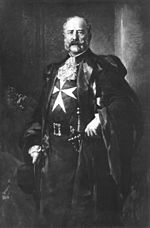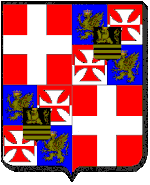Johann Baptist Ceschi a Santa Croce
Fra 'Johann Baptist Ceschi a Santa Croce, Count of Cavedine , also Fra' Giovanni Battista Ceschi a Santa Croce, conte di Cavedine (born February 21, 1827 in Venice , † January 24, 1905 in Rome ) was an Austrian nobleman of Italian descent and from March 28, 1879 until his death, the 74th Grand Master of the Order of Malta . He belonged to the Italian noble family Ceschi a Santa Croce ( count 1570).
biography
Fra 'Johann Baptist Ceschi a Santa Croce, Count of Cavedine was the elected successor of Fra ′ Alessandro Borgia (1783–1872) as Luogotenente del magisterio (governor of the Grand Magisterium) until Pope Leo XIII. with the bull Inclytum antiquitate originis of March 28, 1879 restored the dignity of the grand master , which has not existed in the order since the death of the last grand master Giovanni Battista Tommasi in 1805, and which Ceschi clothed with.
After the Order of Malta had temporarily withdrawn to Messina , Catania and in 1826 to Ferrara from June 11, 1798 after the loss of Malta , it finally settled in Rome in 1834 , where he built the Grand Master’s Palace, which has been under the protection of extraterritoriality since 1869 in Via Condotti 68 and owns the villa on the Aventine.
In 1880 Ceschi a Santa Croce (and his successors in the grand master class) was awarded the rank of prince by Emperor Franz Joseph I in Vienna .
He initiated the establishment of the national associations of lay people of the order (knights without profession ). Then the national associations of the order came into being.
Individual evidence
- ↑ Gothaisches Genealogical Pocket Book of the Count's Houses, Verlag Justus Perthes, Gotha 1917, p. 81
Web links
- http://www.smom-za.org/grandmasters/74.htm
- The 79 Grand Masters ( Memento from December 24, 2007 in the Internet Archive )
| predecessor | Office | successor |
|---|---|---|
| Giovanni Battista Tommasi |
Grand Master of the Order of Malta 1879–1905 |
Galeas of Thun and Hohenstein |
| personal data | |
|---|---|
| SURNAME | Ceschi a Santa Croce, Johann Baptist |
| ALTERNATIVE NAMES | Ceschi a Santa Croce, Giovanni Battista |
| BRIEF DESCRIPTION | Grand Master of the Order of Malta |
| DATE OF BIRTH | February 21, 1827 |
| PLACE OF BIRTH | Venice |
| DATE OF DEATH | January 24, 1905 |
| Place of death | Rome |

